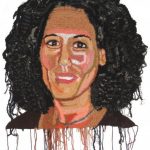Jo Hamilton
Jo Hamilton (1972-) was born in Glasgow, Scotland, and completed her BA in Art at the Glasgow School of Art in 1993.
“I use crochet nontraditionally to create large-scale figurative art and to invest the craft with contemporary significance. My work filters the culture of fine art through traditional craft, reworking and transforming the classical categories of portraiture, landscape, and nudes, and in the process confronting past and present biases and shifts in gender roles and identity. I am interested in how Western preconceptions of social status and progress determine the meaning and value of an image and its subject: what is represented, what is ignored, and why. My portraits depict members of society who are less seen, such as residents of the local AIDS care facility where I volunteer; my landscapes reveal the so-called progress that is dismantling the city; and my giant, ambiguous male nudes reverse the gendered tradition of male artist/female reclining nude. My Masks series portrays anonymous masked women and girls with a superheroic subtext. Another ongoing series appropriates and softens mug shots of arrestees in order to restore the humanity that has been erased in a single negative moment.
“Crochet is a method of making fabric using a hook. It has a distinct language, older than and unchanged by recorded art history. It speaks to and of generations of women, and universally to everyone who has ever handled textiles. I was taught to crochet as a child by my Gran. It became part of my studio practice in 2006, when a local textile exhibition inspired me to unite my love of crochet with my years of experience as a painter. I developed my technique through long hours of tying knots, and even more unraveling.
“My process is unusual: I work from an image using no plans or sketches, and mix the yarns knot by knot, building tiers of color like brushstrokes to define my subjects. With each portrait I always begin with the eyes, using the rows of stitches like lines to define the facial structure, working outward until the person is captured in my knots. The subjects are created from and contained within the handmade fabric, and the knots suggest units of time and reveal the physical process.”

